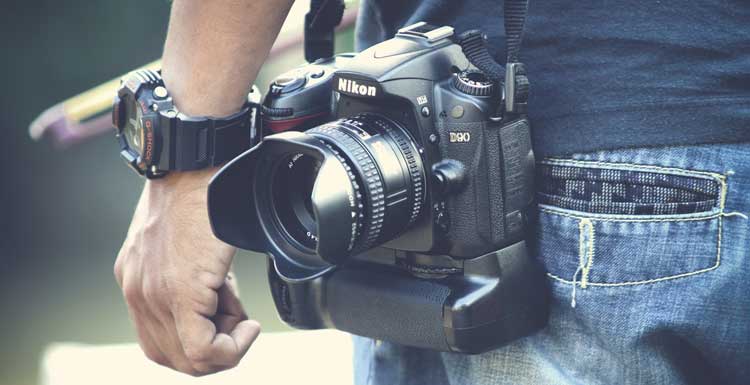Make money from stock photography
James McMath
17 Jul 2017
Updated: 19 Nov 2023
If you're a keen photographer, it's possible to turn your hobby into an earning tool by learning how to make money from stock photography.
Stock photography sites such as ShutterStock and iStock rely massively on contributors to keep their archive comprehensive and current.
Stock photos are used by publishers such as news sites and blogs to illustrate articles. They are usually generic images or videos. Stock pictures can illustrate almost anything - from situations, to locations, emotions and abstract ideas.
How to make money from stock photography
To make money from stock photography, you'll need: 1. Good equipment 2. A strong creative streak and an eye for an image. 3. Time and patience. 4. A comprehensive portfolio of work. The amount you can earn from each picture is very little so you need to stand out in a very competitive marketplace to increase the chances of your photographs being downloaded to boost your earnings.
How much do ShutterStock pay for pictures?
This depends on the type of picture and licence you have agreed to.
For subscription licensed-pictures, Shutterstock will initially pay you 25 cents (about 20p) every time one of your images is downloaded, with a tiered set of raises per download as you reach the £380, £2,300 and £7,700 lifetime earning milestones.
Stock photographs with other licence types attract higher fees. For example, On Demand downloads allow the customer to use the picture freely for a year and these start at about £1.40.
If you get it right, selling stock photos can be a great way of earning money in your spare time.
Get the right equipment but don't break the bank
Services such as Shutterstock charge a fee for access to their pictures, so their clients expect quality.
ShutterStock's library includes more than 50 million royalty-free images and over 3 million footage clips. The company has served more than 500 million downloads to over 1 million customers in 150 countries since the company was founded in 2003. So, as you can imagine, it's quite a competitive marketplace.

Some of the world's leading publishers - both online and print - use Shutterstock, so images have to be of a very high standard. Even the best pictures from your smartphone are unlikely to cut it.
You will need to invest in a professional camera and lenses at the very least and other equipment such as lighting, tripods and cases if you are going to take it really seriously. Also, think about video - the demand for stock video is ever-increasing and, if you want a slice of the pie, you'll need a high-quality video camera, capable of shooting in HD or even 4K.
All this, of course, can be very expensive, so it's a good idea to consider renting the equipment, at least in the first instance. If you're not sure how often you will use, say, a lighting stand, rent it first and gauge how useful it is.
You should also consider sharing resources such as equipment or studio space with other photographers.
What to shoot
When hoping to make money from stock photography, it's important to think like a business and that means satisfying a demand. Shutterstock has some advice on what customers are looking for:
Authenticity
Perfectly posed images of beautiful models are popular, but buyers tell us every day that they also want authenticity.
"Try to build a comprehensive catalogue of photographs or videos"
Images need to be inspirational, professional, and of high quality, but people and activities should look natural, relaxed, and “real.”
Diversity
We live in an increasingly global economy and shared culture. For years, buyers have been asking stock agencies for images that reflect how culturally diverse our world is in a way that feels honest and accurate.

Cultural credibility
Shutterstock serves a global audience. Does a business meeting in Hong Kong or Rio De Janeiro look exactly the same as one in London or Rome? Don’t copy “popular” images. Buyers want high-quality and authentic images of the world as seen through your eyes.
Variety
Buyers often tell us things like this: “The shot was perfect – but we couldn’t use it because the person was serious, not smiling.” Or the image was horizontal, not vertical. By shooting distinct and unique variations of the same scene, you can give a buyer options while
Make space for words
Your images need to have a clear centre of interest, but have you thought about how text might be overlaid on the image?
Think about a magazine cover, advertisement, or two-page spread. Where do photographers leave room for text? What techniques do they use – like shallow depth-of-field – to create a suitable space for text?
Originality
We were recently approached by a potential customer who works for a government agency specialising in
wastewater treatment. She was a regular buyer of images of sewer sludge.
Who would imagine that? Popular themes such as nature, objects, business, and healthcare may seem obvious to beginners, but since those categories are saturated, finding images of unique subjects should also be a major part of your portfolio strategy.
"Enter 25-45 accurate, relevant, and properly spelled keywords for each photo"
These images might not be the top sellers, but your unique, niche images are up against less competition, and will help you diversify your portfolio.
Build you portfolio
Take great pictures or video is, of course, the key but a big catalogue of pictures will also help your chances. Try to build a comprehensive catalogue of photographs or videos to increase the chance of your photo being chosen by a customer. Remember, it's a numbers game and the bigger your numbers, the more chance you have of making money from stock photography.
Keywords are key
To have any chance of making money from stock photography, you will need to make sure people can find them. This means adding specific and relevant keywords. Think like a publisher - what words would they search for to find your images?
ShutterStock's advice is: "For the most part, buyers don’t find your images by visuals alone. Search engines
match a buyer’s search terms to the keywords you’ve entered. Better keywords = better sales. Accurate keywords = better sales.
"If you enter 25-45 accurate, relevant, and properly spelled keywords for each photo, your chances of success are very high."
